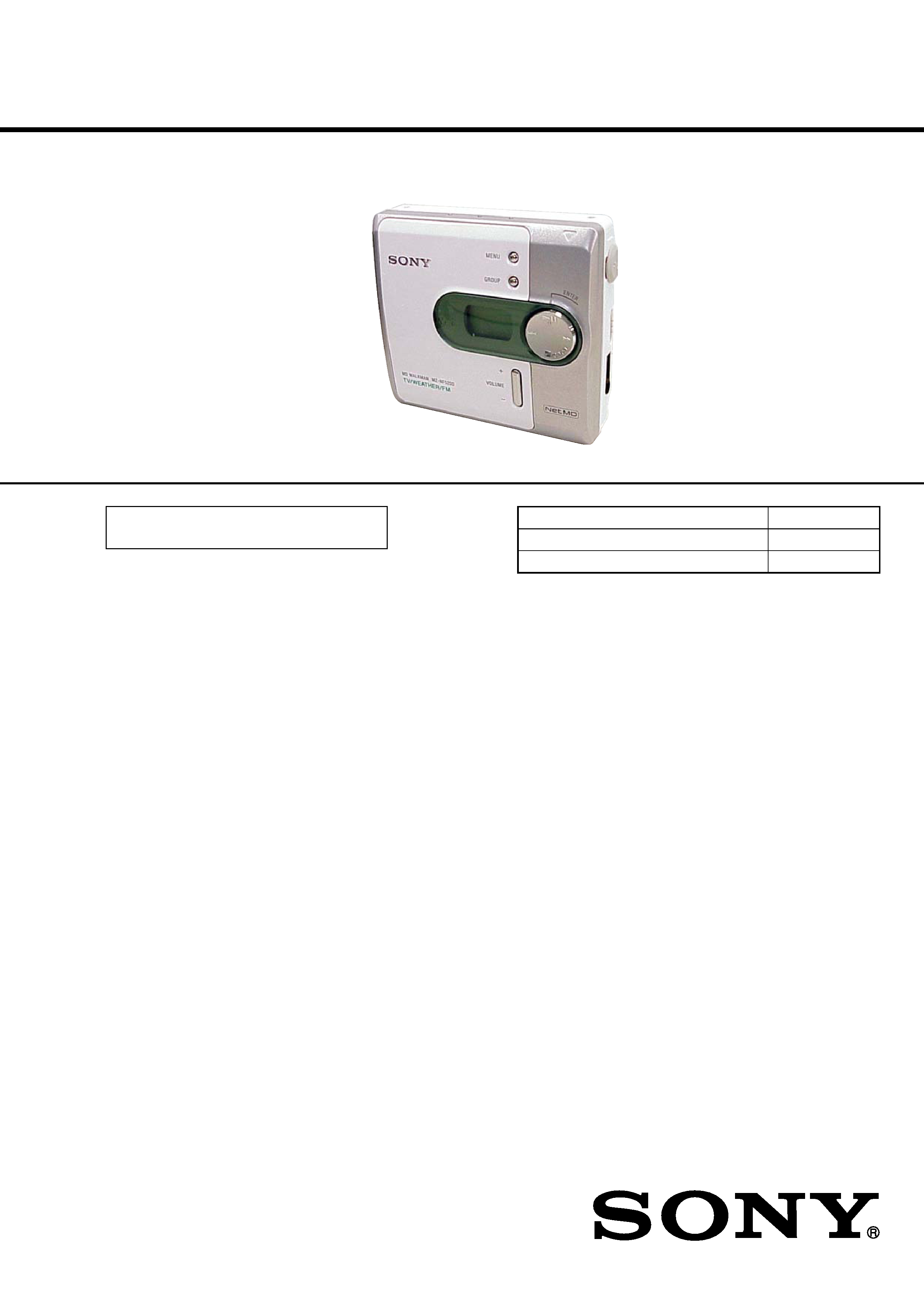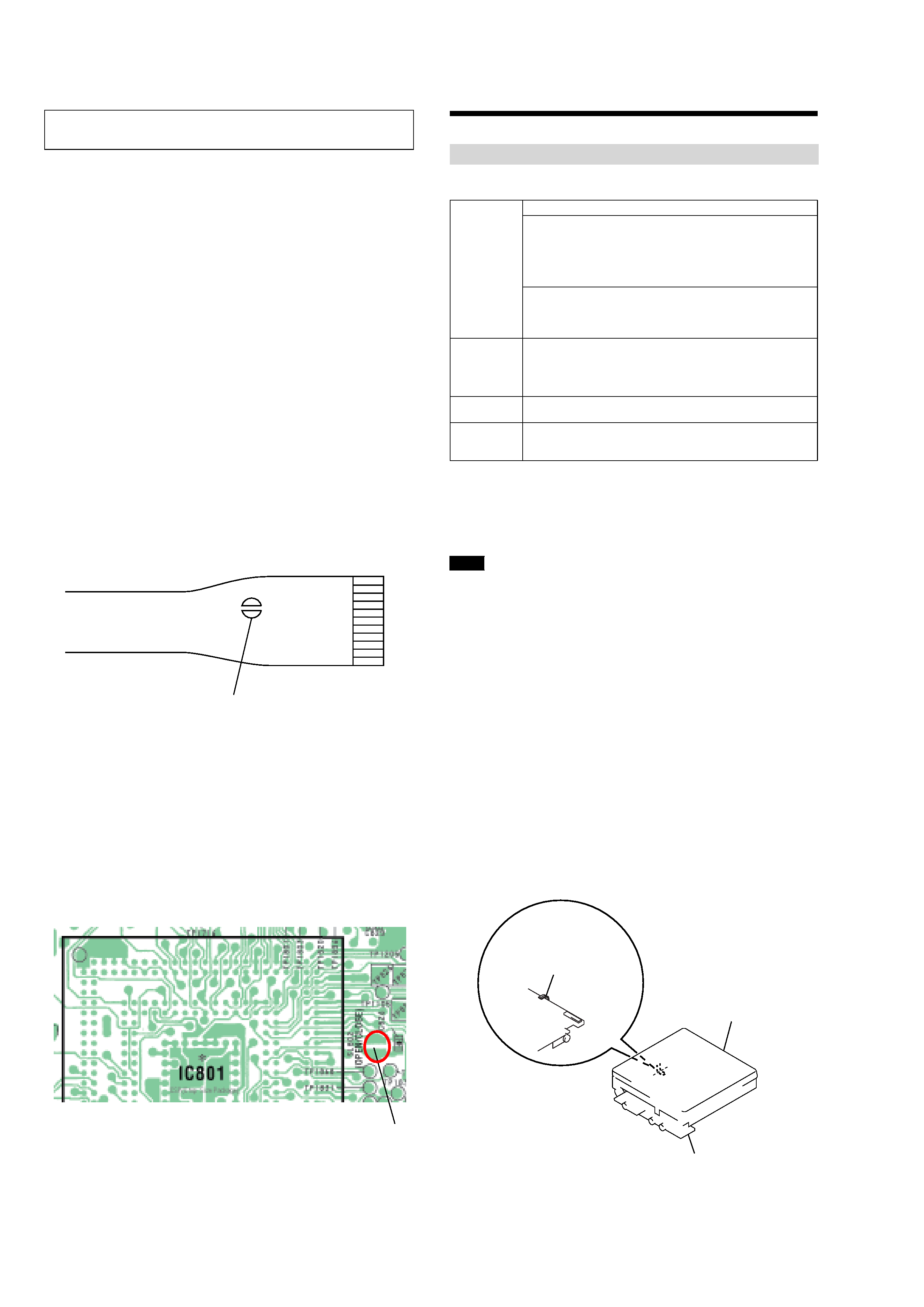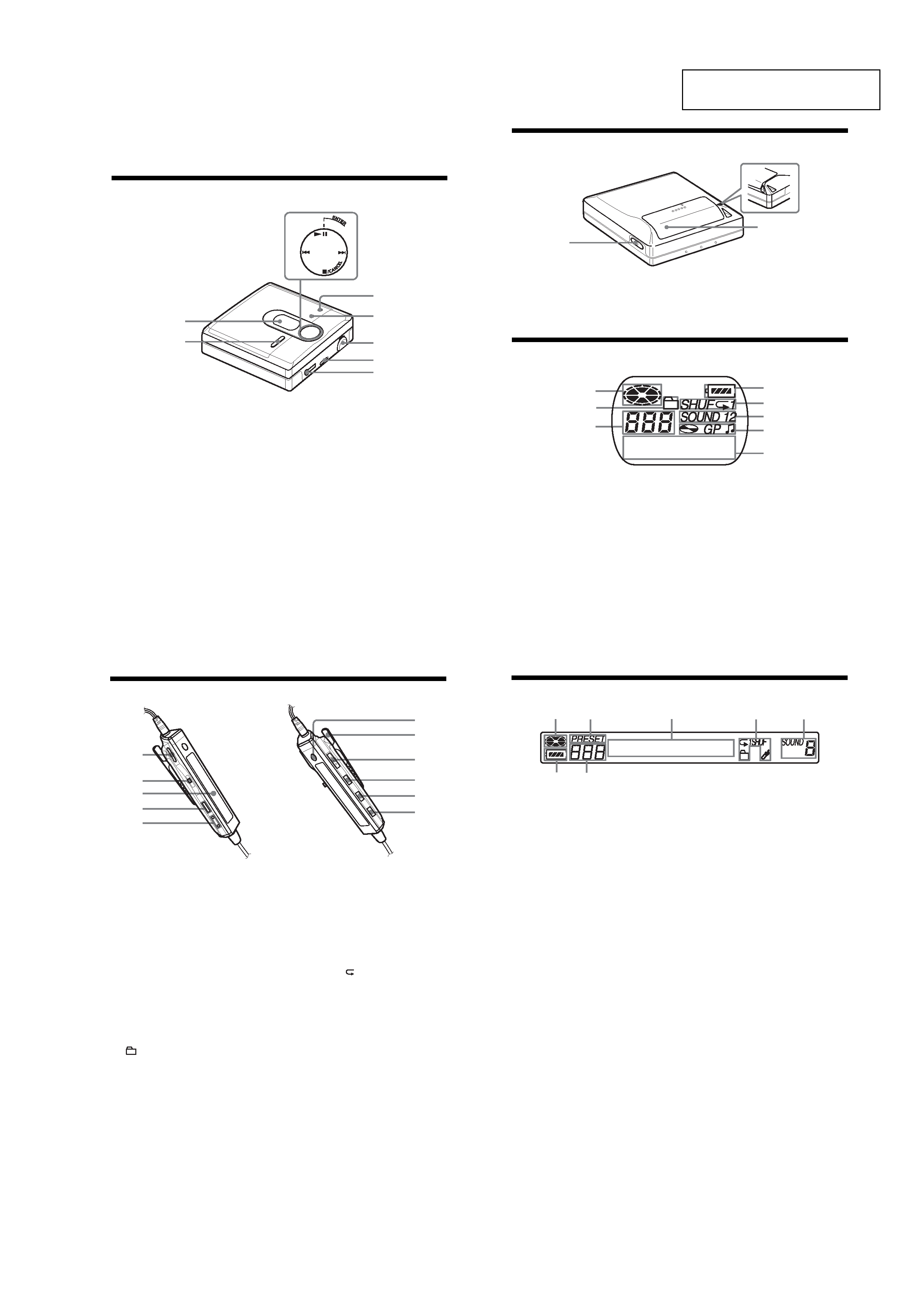
SERVICE MANUAL
PORTABLE MINIDISC PLAYER
US Model
Canadian Model
SPECIFICATIONS
MZ-NF520D
US and foreign patents licensed from Dolby
Laboratories.
Continued on next page
Model Name Using Similar Mechanism
MZ-NE410
Mechanism Type
MT-MZN710-177
Optical Pick-up Name
LCX-5R
Ver 1.0 2004.03
9-877-578-01
Sony Corporation
2004C1678-1
Personal Audio Company
C
2004.03
Published by Sony Engineering Corporation
· SonicStage, MD Simple Burner,
OpenMG, Magic Gate, MagicGate
Memory Stick, Memory Stick, Net MD,
ATRAC, ATRAC3, ATRAC3plus and
their logos are trademarks of Sony
Corporation.
· Microsoft, Windows, Windows NT and
Windows Media are trademarks or
registered trademarks of Microsoft
Corporation in the United States and /or
other countries.
· IBM and PC/AT are registered
trademarks of International Business
Machines Corporation.
· Macintosh is a trademark of Apple
Computer, Inc. in the United States and/
or other countries.
· MMX and Pentium are trademarks or
registered trademarks of Intel
Corporation.
· All other trademarks and registered
trademarks are trademarks or registered
trademarks of their respective holders.
· TM and ® marks are omitted in this
manual.
MD Player
Audio playing system
MiniDisc digital audio system
Laser diode properties
Material: GaAlAs
Wavelength:
= 790 nm
Emission duration: continuous
Laser output: less than 44.6
µW
(This output is the value measured at a distance
of 200 mm from the objective lens surface on
the optical pick-up block with 7 mm aperture.)
Recording and playback time (when
using MDW-80)
Maximum 160 min. in monaural
Maximum 320 min. in LP4 stereo
Revolutions
Approx. 380 rpm to 2,700 rpm
Error correction
ACIRC (Advanced Cross Interleave Reed
Solomon Code)
Sampling frequency
44.1 kHz
Coding
ATRAC (Adaptive TRansform Acoustic
Coding)
ATRAC3 -- LP2/LP4
Modulation system
EFM (Eight to Fourteen Modulation)

2
MZ-NF520D
SAFETY-RELATED COMPONENT WARNING!!
COMPONENTS IDENTIFIED BY MARK 0 OR DOTTED LINE
WITH MARK 0 ON THE SCHEMATIC DIAGRAMS AND IN THE
PARTS LIST ARE CRITICAL TO SAFE OPERATION. REPLACE
THESE COMPONENTS WITH SONY PARTS WHOSE PART NUM-
BERS APPEAR AS SHOWN IN THIS MANUAL OR IN SUPPLE-
MENTS PUBLISHED BY SONY.
ATTENTION AU COMPOSANT AYANT RAPPORT
À LA SÉCURITÉ!
LES COMPOSANTS IDENTIFÉS PAR UNE MARQUE 0 SUR LES
DIAGRAMMES SCHÉMATIQUES ET LA LISTE DES PIÈCES
SONT CRITIQUES POUR LA SÉCURITÉ DE FONCTIONNEMENT.
NE REMPLACER CES COMPOSANTS QUE PAR DES PIÈSES
SONY DONT LES NUMÉROS SONT DONNÉS DANS CE MANUEL
OU DANS LES SUPPÉMENTS PUBLIÉS PAR SONY.
Number of channels
2 stereo channels
1 monaural channel
Frequency response
20 to 20,000 Hz
± 3 dB
Outputs
i: stereo mini-jack, maximum output level
5 mW + 5 mW, load impedance 24
(USA)
5 mW + 5 mW, load impedance 16
(Canada)
Radio
Frequency range
USA model:
FM: 87.5 - 108.0 MHz
TV: 2 - 13 CH
WEATHER: 1 - 7 CH
Canadian model:
FM: 87.5 - 108.0 MHz
Antenna
FM/TV/WEATHER:
Headphones/earphones cord antenna
General
Power requirements
One LR6 (size AA) alkaline battery (not
supplied)
Recommended temperature for
check-in/check-out
+5
° C (+41° F) or higher
Dimensions
Approx. 81
× 30.7 × 74.4 mm (w/h/d) (31/4 ×
11/4
× 3 in.) without projections.
Mass
Approx. 115 g (4.1 oz) the player only
US and foreign patents licensed from Dolby
Laboratories.
Design and specifications are subject to change
without notice.
Battery operation time
Supplied accessories
* Do not play a CD-ROM on an audio CD player.
CD-ROM (SonicStage Ver. 2.0 and MD Simple Burner Ver. 2.0) (1)*
Headphones with a remote control (1) (for USA model)
Dedicated USB cable (1)
Earphones with a remote control (1) (for Canadian model)
1) When using a new Sony LR6 (size AA) alkaline dry battery (produced in Japan).
When
SP Stereo
LP2 Stereo
LP4 Stereo
playing2)
2) Measured in accordance with the JEITA (Japan Electronics and Information Technology Industries
Association) standard.
Approx. 36 hours
Approx. 42.5 hours
Approx. 48 hours
transferring audio data
from the computer3)
3) The numbers of tracks that can be transferred differs according to the computer's operating
environment.
55 tracks (of about
5 minutes each)
230 tracks (of about
5 minutes each)
325 tracks (of about
5 minutes each)
When
FM
TV/Wb(weather)(USA model only)
using the radio
Approx. 18.5 hours
Approx. 17 hours

3
MZ-NF520D
CAUTION
Use of controls or adjustments or performance of procedures
other than those specified herein may result in hazardous ra-
diation exposure.
Notes on chip component replacement
·Never reuse a disconnected chip component.
· Notice that the minus side of a tantalum capacitor may be dam-
aged by heat.
Flexible Circuit Board Repairing
·Keep the temperature of the soldering iron around 270 °C dur-
ing repairing.
· Do not touch the soldering iron on the same conductor of the
circuit board (within 3 times).
· Be careful not to apply force on the conductor when soldering
or unsoldering.
UNLEADED SOLDER
Boards requiring use of unleaded solder are printed with the lead-
free mark (LF) indicating the solder contains no lead.
(Caution: Some printed circuit boards may not come printed with
the lead free mark due to their particular size)
: LEAD FREE MARK
Unleaded solder has the following characteristics.
· Unleaded solder melts at a temperature about 40 °C higher than
ordinary solder.
Ordinary soldering irons can be used but the iron tip has to be
applied to the solder joint for a slightly longer time.
Soldering irons using a temperature regulator should be set to
about 350 °C .
Caution: The printed pattern (copper foil) may peel away if the
heated tip is applied for too long, so be careful!
· Strong viscosity
Unleaded solder is more viscous (sticky, less prone to flow) than
ordinary solder so use caution not to let solder bridges occur
such as on IC pins, etc.
· Usable with ordinary solder
It is best to use only unleaded solder but unleaded solder may
also be added to ordinary solder.
1. SERVICING NOTES ....................................................... 4
2. GENERAL .......................................................................... 5
3. DISASSEMBLY
3-1. Disassembly Flow .......................................................... 6
3-2. Case (Lower) .................................................................. 7
3-3. MAIN Board ................................................................... 7
3-4. Panel (Upper) Section .................................................... 8
3-5. LCD Module, Button (Control) ..................................... 8
3-6. Mechanism Deck (MT-MZN710-177) .......................... 9
3-7. Set Chassis Assy ............................................................. 9
3-8. OP Service Assy (LCX-5R) ......................................... 10
3-9. Holder Assy .................................................................. 11
3-10. DC Motor (Sled) (M602) ........................................... 11
3-11. DC Motor (Over Write Head Up/Down) (M603),
DC SSM18B Motor (Spindle) (M601) ...................... 12
4. TEST MODE .................................................................... 13
5. ELECTRICAL ADJUSTMENTS ............................... 18
6. DIAGRAMS
6-1. Block Diagram ............................................................. 37
6-2. Printed Wiring Board - MAIN Board (Side A) ........... 39
6-3. Printed Wiring Board - MAIN Board (Side B) ........... 40
6-4. Schematic Diagram - MAIN Board (1/4) .................... 41
6-5. Schematic Diagram - MAIN Board (2/4) .................... 42
6-6. Schematic Diagram - MAIN Board (3/4) .................... 43
6-7. Schematic Diagram - MAIN Board (4/4) .................... 44
6-8. IC Pin Function Description ........................................ 49
7. EXPLODED VIEWS
7-1. Case Section ................................................................. 55
7-2. Chassis Section ............................................................. 56
7-3. MAIN Board Section ................................................... 57
7-4. Mechanism Deck Section-1 (MT-MZN710-177) ........ 58
7-5. Mechanism Deck Section-2 (MT-MZN710-177) ........ 59
8. ELECTRICAL PARTS LIST ....................................... 60
TABLE OF CONTENTS

4
MZ-NF520D
NOTES ON HANDLING THE OPTICAL PICK-UP
BLOCK OR BASE UNIT
The laser diode in the optical pick-up block may suffer electro-
static break-down because of the potential difference generated
by the charged electrostatic load, etc. on clothing and the human
body.
During repair, pay attention to electrostatic break-down and also
use the procedure in the printed matter which is included in the
repair parts.
The flexible board is easily damaged and should be handled with
care.
NOTES ON LASER DIODE EMISSION CHECK
Never look into the laser diode emission from right above when
checking it for adjustment. It is feared that you will lose your sight.
NOTES ON HANDLING THE OPTICAL PICK-UP BLOCK
(LCX-5R)
The laser diode in the optical pick-up block may suffer electro-
static break-down easily. When handling it, perform soldering
bridge to the laser-tap on the flexible board. Also perform mea-
sures against electrostatic break-down sufficiently before the op-
eration. The flexible board is easily damaged and should be handled
with care.
OPTICAL PICK-UP FLEXIBLE BOARD
SECTION 1
SERVICING NOTES
laser-tap
· In performing the repair with the power supplied to the set, re-
moving the MAIN board causes the set to be disabled.
In such a case, make a solder bridge to short SL802 (OPEN/
CLOSE) on the MAIN board in advance.
upper panel assy
MAIN board
FLEXIBLE board
(over write head)
·This set requires the patch data in the nonvolatile memory
(IC852) to be rewritten using the application, when the MAIN
board was replaced. (See page 28)
Handle the FLEXIBLE board (over write head) with care, as it
has been soldered directly to the MAIN board.
In repairing the component side of MAIN board, connect the
FLEXIBLE board (over write head) and the MAIN board with
the lead wires in advance.
SL802
(OPEN/CLOSE)
- MAIN board (Side B) -
Providing the required system environment
The following system environment is required in order to use the SonicStage Ver. 2.0/MD
Simple Burner Ver. 2.0 software for the MD Walkman.
This software is not supported by the following environments:
OSs other than the indicated above
Personally constructed PCs or operating systems
An environment that is an upgrade of the original manufacturer-installed operating system
Multi-boot environment
Multi-monitor environment
Macintosh
We do not ensure trouble-free operation on all computers that satisfy the system requirements.
The NTFS format of Windows XP/Windows 2000 Professional can be used only with the standard
(factory) settings.
We do not ensure trouble-free operation of the system suspend, sleep, or hibernation function on all
computers.
For Windows 2000 Professional users, install Service Pack 3 or later version before using the
software.
System requirements
Computer
IBM PC/AT or Compatible
·CPU: Pentium II 400 MHz or higher (Pentium III 450 MHz or higher
is recommended.)
·Hard disk drive space: 200 MB or more (1.5 GB or more is
recommended) (The amount space will vary according to Windows
version and the number of music files stored on the hard disk.)
·RAM: 64 MB or more (128 MB or more is recommended)
Others
·CD drive (capable of digital playback by WDM)
·Sound Board
·USB port (supports USB (previously USB 1.1))
Operating
System
Factory installed:
Windows XP Media Center Edition 2004/Windows XP Media Center
Edition/Windows XP Professional/Windows XP Home Edition/
Windows 2000 Professional/Windows Millennium Edition/Windows
98 Second Edition
Display
High Color (16bit) or higher, 800
× 600 dots or better (1024 × 768 dots
or better is recommended)
Others
· Internet access: for Web registration, EMD services and CDDB
·Windows Media Player (version 7.0 or higher) installed for playing
WMA files
Notes

5
MZ-NF520D
SECTION 2
GENERAL
Looking at the controls
Front of the player
A Display window
B VOLUME +* and button
* The VOLUME + button has a tactile
dot.
C 4-position control key
ENTER/NX (enter/play/pause)*
. and > (search/AMS)
x/CANCEL (stop/cancel)
* The ENTER/NX button has a tactile
dot.
D MENU button
E GROUP button
F USB jack
When connecting to your computer,
connect the dedicated USB cable to
this jack.
G HOLD switch
H i (headphones/earphones) jack
3
5
6
7
4
8
1
2
Back of the player
A OPEN button
B Hand strap hole
Use the hole to attach your own strap.
C Battery compartment lid
The display window of the player
A Disc indication
B Group mode indication
Lights up when group mode is on.
C Track number display
D Battery level indication
Shows approximate battery condition.
E Play mode indication
Shows play mode of the MD.
F SOUND indication
G Disc, group, track indication
H Character information display
Displays the track names, elapsed
time, etc.
1
3
2
1
2
3
4
5
6
7
8
The headphones/earphones with a remote control
A VOL +, buttons
Press to adjust the volume.
B Jog lever (. · NX/ENT · >,
TUNE · BAND · TUNE +)
NX/ENT (to press): play, pause,
enter
.(to slide towards): REW
> (to slide towards): FF
BAND (to press): select a band
TUNE (to slide towards): tune
backward
TUNE + (to slide towards): tune
forward
C Display window
D x (stop) button
E
(group) +, buttons
F RADIO ON/OFF button
Press to turn on or off the radio.
G Clip
H HOLD switch
To prevent the buttons from being
accidentally operated when you carry
the player, use this function.
I DISPLAY button
J P-MODE/
button
K SOUND button
F
G
H
I
J
K
B
C
D
E
A
The display window of the remote control
A Disc indication
B PRESET indication
C Character information display
D Play mode indication
E SOUND indication
F Battery level indication
G Track number/Band/Preset number
display
F
G
B
AC
D
E
This section is extracted from
instruction manual.
